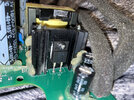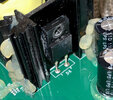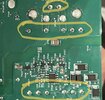Hello,
Trying to troubleshoot a defect Sonos Sub since it doesn’t start.
I have started some measurements and I have observed the following which might sound strange.
The Bridge Rectifer, when measuring between negative and positive is showing around 0.56V while I expected around 0.9V since two diodes are in series. Does it mean it is defect? When measuring between other combinations on the bridge rectifier, it seems to be fully working with regard to voltage drop and resistance except for the 0.9V.
However, there is another part that caught my attention. I have measured this part (shown in the picture) and it seems to be defect. When I do diode measurement, I am getting 0.0V in both directions and ohm measurement of 0.2 ohm in both directions as well (suspected short). It seems to be connected to the transformer just behind it. But I cannot find a replacement for this as there is no marking on it. Maybe it’s a difficult question, but how do I proceed after this? Thank you.
Trying to troubleshoot a defect Sonos Sub since it doesn’t start.
I have started some measurements and I have observed the following which might sound strange.
The Bridge Rectifer, when measuring between negative and positive is showing around 0.56V while I expected around 0.9V since two diodes are in series. Does it mean it is defect? When measuring between other combinations on the bridge rectifier, it seems to be fully working with regard to voltage drop and resistance except for the 0.9V.
However, there is another part that caught my attention. I have measured this part (shown in the picture) and it seems to be defect. When I do diode measurement, I am getting 0.0V in both directions and ohm measurement of 0.2 ohm in both directions as well (suspected short). It seems to be connected to the transformer just behind it. But I cannot find a replacement for this as there is no marking on it. Maybe it’s a difficult question, but how do I proceed after this? Thank you.



